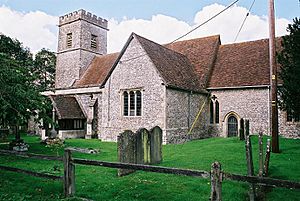Shalbourne facts for kids
Quick facts for kids Shalbourne |
|
|---|---|
 St. Michael and All Angels |
|
| Population | 558 (in 2011) |
| OS grid reference | SU3163 |
| Unitary authority |
|
| Ceremonial county | |
| Region | |
| Country | England |
| Sovereign state | United Kingdom |
| Post town | Marlborough |
| Postcode district | SN8 |
| Post town | Hungerford |
| Postcode district | RG17 |
| Dialling code | 01672 |
| Police | Wiltshire |
| Fire | Wiltshire |
| Ambulance | Great Western |
| EU Parliament | South West England |
| UK Parliament |
|
Shalbourne is a small village and civil parish located in the English county of Wiltshire. It is about 3 miles (4.8 km) southwest of Hungerford, which is in Berkshire. The parish of Shalbourne includes several smaller communities spread out across the area. These include Bagshot and Stype to the north, and Rivar and Oxenwood to the south. Before 1895, about half of Shalbourne parish, including its church, was actually part of Berkshire.
Contents
A Glimpse into Shalbourne's Past
How Old is Shalbourne?
Shalbourne has a long history. In 1086, a very important book called the Domesday Book recorded a settlement here. It was known as Saldeborne or Scaldeburne back then. This record shows that 48 households lived in the area at that time.
Changes to the Parish Borders
Over time, the borders of Shalbourne parish changed. In 1844, a part of the parish called Oxenwood was moved from Berkshire to Wiltshire. Later, in 1895, the Bagshot area was also transferred. These changes helped to bring the entire parish of Shalbourne fully into Wiltshire.
Exploring Shalbourne's Church
St Michael and All Angels Church
The Anglican Church of St Michael and All Angels is a very old and important building. It is listed as Grade II*, which means it is a building of special historical interest. The church was built with flint and stone, and has tiled roofs. It dates back to the 12th or 13th century.
Church Design and History
The church was partly rebuilt and made bigger in 1873 by an architect named G.F. Bodley. The main part of the church, called the nave, might be from the 12th century or rebuilt in the 13th century. During the 19th-century changes, two old 12th-century doorways were reused. The chancel, which is the area around the altar, was rebuilt around 1300. The tall tower was added in the 15th century.
Bells and Stained Glass
The church tower has six bells, and three of them are very old, dating back to the 17th century. The east window in the chancel has beautiful stained glass from 1871, made by Kempe. A newer window, designed by Karl Parsons and made by Henry Haig, was added in 1995. Karl Parsons lived in Shalbourne for a few years in the 1930s.
Modern Church Connections
Since 1956, the church has been connected with the parishes of Ham with Buttermere. Today, Shalbourne is part of the Savernake Team, which is a group of eleven village parishes working together.
Other Historic Buildings in Shalbourne
Besides the church, there are other old and important buildings in Shalbourne. West Court farmhouse, which dates from the 15th and 17th centuries, is also a Grade II* listed building. Shalbourne Manor farmhouse, built in the 16th century, also holds this special historical status.
Shalbourne's Natural Features
The Shalbourne Stream
The Shalbourne Stream is a small waterway that starts from a spring near Shalbourne village. It flows northeast and eventually joins the River Dun. The River Dun then flows into the River Kennet above Hungerford.
What Can You Find in Shalbourne?
Village Amenities and Activities
Shalbourne has a primary school for younger students. There is also a village hall, which was originally built as a schoolroom in 1843. For sports lovers, the village has a cricket pitch and a pavilion with a bar. In the heart of the village, near the village green, you'll find The Plough pub. There's also a small post office and shop that sells various products and refreshments. This shop even stocks organic vegetables from Shalbourne's own community project, which is a small allotment that provides fresh vegetable boxes to the village and nearby areas.
Famous People Connected to Shalbourne
Notable Figures from Shalbourne's History
- Alexander Chocke of Shalbourne (1594–1625) was a person from Shalbourne who was chosen to be a Member of Parliament for Ludgershall in 1621.
- From 1608 to 1637, William Carpenter and his son, also named William, lived at Westcourt Manor in Shalbourne. They later moved to America in 1638 on a ship called the Bevis. The younger William helped to start the town of Rehoboth, Massachusetts. Many thousands of people today are descendants of this family, including two U.S. presidents and a Project Mercury astronaut. William Carpenter Jr. married Abigail Briant in Shalbourne in 1625.
- Jethro Tull (1674–1741) was an important person in agriculture. From 1709, he owned Prosperous farm, which was close to the edge of the current Shalbourne parish.
- Marguerite de Beaumont (1899–1989) was one of the people who helped start the Girl Guides. She also wrote about Lord Baden-Powell, who founded the Scouting movement. She received the Silver Fish Award, which is the highest honor for adult Girl Guiding members.
See also
 In Spanish: Shalbourne para niños
In Spanish: Shalbourne para niños



